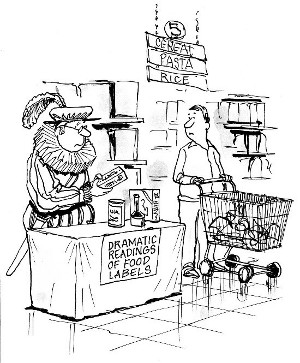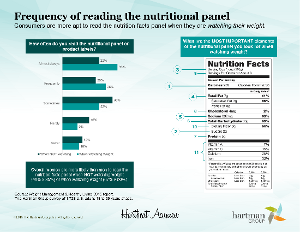LEARNING ABOUT NUTRITION: MOST CONSUMERS DO READ PRODUCT LABELS — THE FDA GETS IT (CONSUMERS ALWAYS DID)
 While it has been more than two decades since the FDA modified the Nutrition Facts panel, consumers may welcome the recent announcement that the panel will finally get its much needed update. While a few organizations have reported that reading the Nutrition Facts panel has fallen out of favor, The Hartman Group’s research reveals a different story: the majority of consumers say they do read the nutritional panel on product labels and varies according to their weight management involvement.
While it has been more than two decades since the FDA modified the Nutrition Facts panel, consumers may welcome the recent announcement that the panel will finally get its much needed update. While a few organizations have reported that reading the Nutrition Facts panel has fallen out of favor, The Hartman Group’s research reveals a different story: the majority of consumers say they do read the nutritional panel on product labels and varies according to their weight management involvement.
Recent reports out of the Centers for Disease Control and Prevention have turned the spotlight squarely back on the obesity epidemic citing that efforts to curb the decades-old crisis in America have not been all that successful. The Nutrition Facts panel refresh may prove timely then because we know that consumers are more apt to read nutritional information on product labels when they are watching their weight.
Among consumers who say they are watching their weight, 81 percent read the nutritional panel on product labels and of these, 59 percent say they frequently or almost always read nutrition labels. Even consumers who aren’t necessarily diet-minded read the Nutrition Facts panel: 72 percent say they read it and among these consumers who are not watching their weight, 42 percent read it frequently or almost always.
 The FDA and other federal regulators are no strangers to the label reading phenomenon. While ploddingly slow in terms of keeping abreast of food culture trends, they make changes to nutritional labels and food pyramids in an ongoing attempt to influence consumers’ to change their eating behaviors to achieve healthier outcomes.
The FDA and other federal regulators are no strangers to the label reading phenomenon. While ploddingly slow in terms of keeping abreast of food culture trends, they make changes to nutritional labels and food pyramids in an ongoing attempt to influence consumers’ to change their eating behaviors to achieve healthier outcomes.
This latest round of purported changes to the Nutrition Facts panel by the FDA seem then to align well with the interests of today’s health-conscious consumers. Consumers want to know what’s in the product and how fresh it is (made on/sell by date labeling), and the amount of calories, sugar, sodium, fat grams and the more nebulous terms like GMOs, healthy, organic and natural.
The motives behind the scrutiny of labels are complex and reflect both involvement and orientation to health and wellness as well as food culture itself.
Nutrition Facts. Critical occasions influencing reading nutrition facts:
- Looking for something specific (protein, fiber)
- Avoiding something specific (sugar, sodium, fat, carbohydrates)
- Just starting out on a diet
- On a diet, but “learning” a new food or beverage (by converting or analyzing nutrition data from the consumer’s personalized “lens”)
- “Checking” a health claim made on the package or establish a serving size
Critical occasions when nutrition facts are not read:
- A product has already been “learned” in terms of its serving size and nutritional content
- A consumers is totally reliant on ingredient lists (may occur with core consumers filtering products for “avoided” or “desired” ingredients)
Ingredient Lists. Critical occasions influencing reading ingredient lists:
- Shopping with a food allergy in mind
- Shopping with a health condition in mind
- Comparing ingredients against health or content claims on the front of a package
- Purchasing a new brand
- “Teaching” ingredients to children (e.g., “See, sugar is the second ingredient…that’s bad”)
- Transparency and food safety concerns (what’s in it; where does it come from)
Critical occasions when ingredient lists are not read:
- A product has already been analyzed (purchased)
- A trusted brand makes a new product (particularly with core consumers and organic foods)
- A consumer is totally reliant on nutrition facts (may occur with “hard-core” followers of diet programs)
On Shopping, Education, Nutrition and Food
All of this brings us to a conundrum of sorts. When it comes to learning, enjoying, creating and dreaming, it is forever about the food and not so much about nutrition.
Many may wonder why we’ve said in the past that shoppers neither need nor desire assistance in making healthy choices while shopping. Our beliefs are always grounded in the voice of the consumer. While we layer our analytic insights on top of those voices, at the end of the day it’s the consumer that drives our perspective.
We have scoured the pantries of thousands of US consumers, and the one truism is that they all know the difference between “what they are supposed to eat” and “what’s not so healthy.” They blush as they push the bag of potato chips to the side. Their eyes light up when a pantry staple reminds them of a recent healthy meal they prepared. They apologize that there are not more fruits and vegetables in their refrigerators. And they clutch their favorite indulgences, in many cases holding them (quite literally) close to their hearts. They get it.
One thing that is consistent at all points on the health and wellness spectrum is that consumers want choices—choices in the brands they buy, the products they use and the information they look to.
